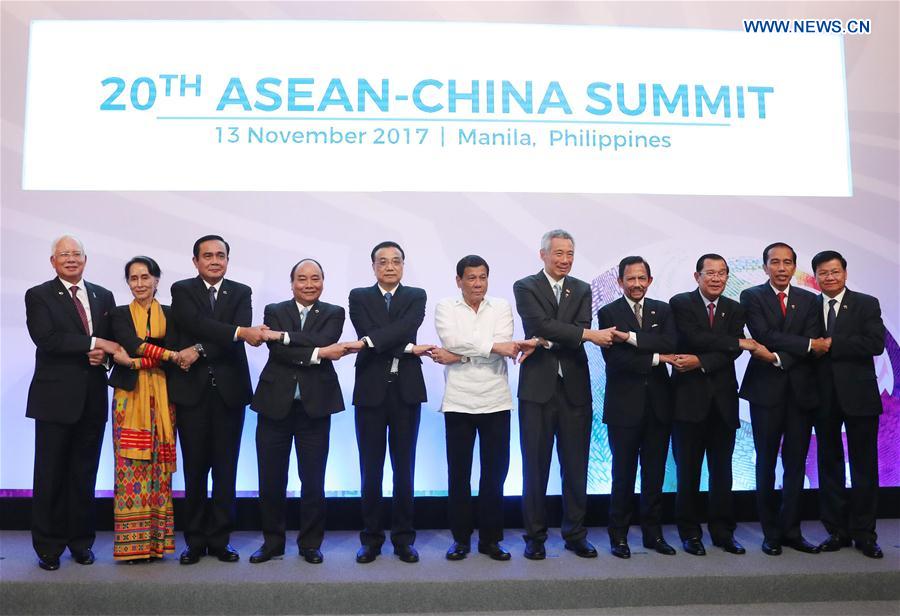


Chinese Premier Li Keqiang (5th L) and leaders of the Association of Southeast Asian Nations (ASEAN) member countries pose for group photos before the 20th China-ASEAN (10+1) leaders' meeting in Manila, the Philippines, Nov. 13, 2017. (Xinhua/Liu Weibing)
China’s proposal to forge an economic community in East Asia is expected to advance cooperation and trade under the East Asia Summit framework, dovetailing with the country’s Belt and Road Initiative, said experts.
Addressing the 20th ASEAN-China, Japan, and South Korea (10+3) Leaders’ Meeting on Tuesday, Chinese Premier Li Keqiang made a six-point proposal concerning regional integration, sustainable development, social progress, joint responses to non-conventional security threats, innovation of security concepts, and improving the regional security framework, Xinhua reported.
“The proposal dovetails with the essence of the Belt and Road Initiative, which also promotes open trade, connectivity, currency circulation, and policy communication. The 10+3 cooperation will further propel the Belt and Road forward, while the latter can inject new vitality into the cooperation among China, South Korea, Japan, and ASEAN countries,” Bai Ming, a research fellow at the Chinese Academy of International Trade and Economic Cooperation, told Thepaper.cn.
In addition to the proposal, Li also said it’s essential to carry forward the alignment of the Belt and Road Initiative with the Master Plan on ASEAN Connectivity 2025 to move faster in implementing the upgraded China-ASEAN Free Trade Area (FTA), and to strive for early completion of the negotiations on the China-Japan-South Korea FTA and the Regional Comprehensive Economic Partnership (RCEP) protocol.
“The proposal of building an economic community in Asia represents a new trend, as countries in East Asia and the Asian-Pacific regions are sharing a closer than ever economic bound following the irreversible process of globalization. It’s necessary to establish a community and promote integration,” He Weiwen, an expert at the Chongyang Institute for Financial Studies at Renmin University of China, told Thepaper.cn.
Though the future for an economic community in East Asia is promising, obstacles still exist. According to experts, China has a relatively smooth relationship with ASEAN countries, while the relationship among China, South Korea, and Japan still faces many challenges.
“Japan is trying to replace the U.S. in Trans-Pacific Partnership (TPP), thus it has less interest in 10+3 and RCEP. I think a TPP without U.S. will have a gloomy future and further divide ASEAN, as some ASEAN countries are not members. RCEP, on the other hand, includes all ASEAN countries, making it more likely to succeed,” said Ruan Zongze, executive vice president of the China Institute of International Studies.
 Fire brigade in Shanghai holds group wedding
Fire brigade in Shanghai holds group wedding Tourists enjoy ice sculptures in Datan Town, north China
Tourists enjoy ice sculptures in Datan Town, north China Sunset scenery of Dayan Pagoda in Xi'an
Sunset scenery of Dayan Pagoda in Xi'an Tourists have fun at scenic spot in Nanlong Town, NW China
Tourists have fun at scenic spot in Nanlong Town, NW China Harbin attracts tourists by making best use of ice in winter
Harbin attracts tourists by making best use of ice in winter In pics: FIS Alpine Ski Women's World Cup Slalom
In pics: FIS Alpine Ski Women's World Cup Slalom Black-necked cranes rest at reservoir in Lhunzhub County, Lhasa
Black-necked cranes rest at reservoir in Lhunzhub County, Lhasa China's FAST telescope will be available to foreign scientists in April
China's FAST telescope will be available to foreign scientists in April "She power" plays indispensable role in poverty alleviation
"She power" plays indispensable role in poverty alleviation Top 10 world news events of People's Daily in 2020
Top 10 world news events of People's Daily in 2020 Top 10 China news events of People's Daily in 2020
Top 10 China news events of People's Daily in 2020 Top 10 media buzzwords of 2020
Top 10 media buzzwords of 2020 Year-ender:10 major tourism stories of 2020
Year-ender:10 major tourism stories of 2020 No interference in Venezuelan issues
No interference in Venezuelan issues
 Biz prepares for trade spat
Biz prepares for trade spat
 Broadcasting Continent
Broadcasting Continent Australia wins Chinese CEOs as US loses
Australia wins Chinese CEOs as US loses